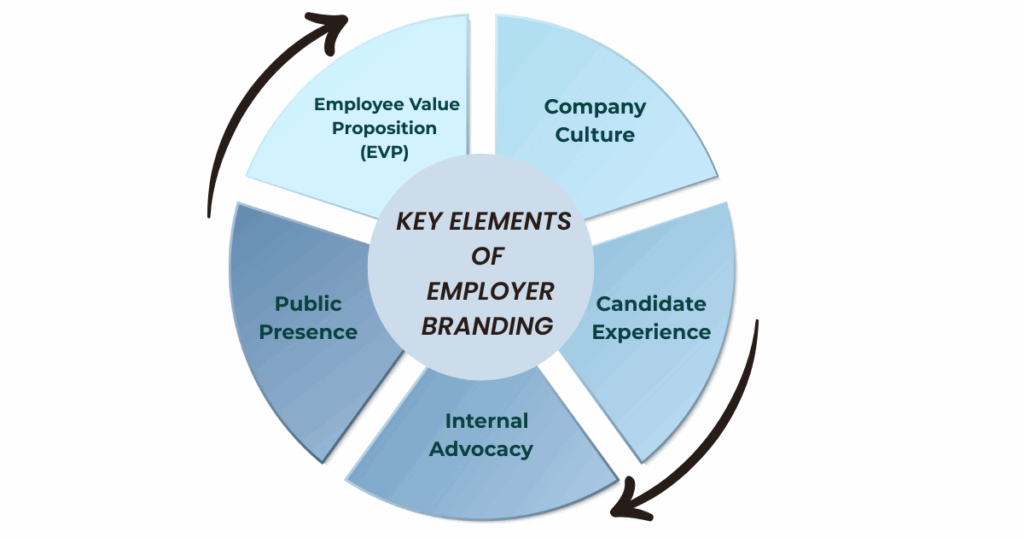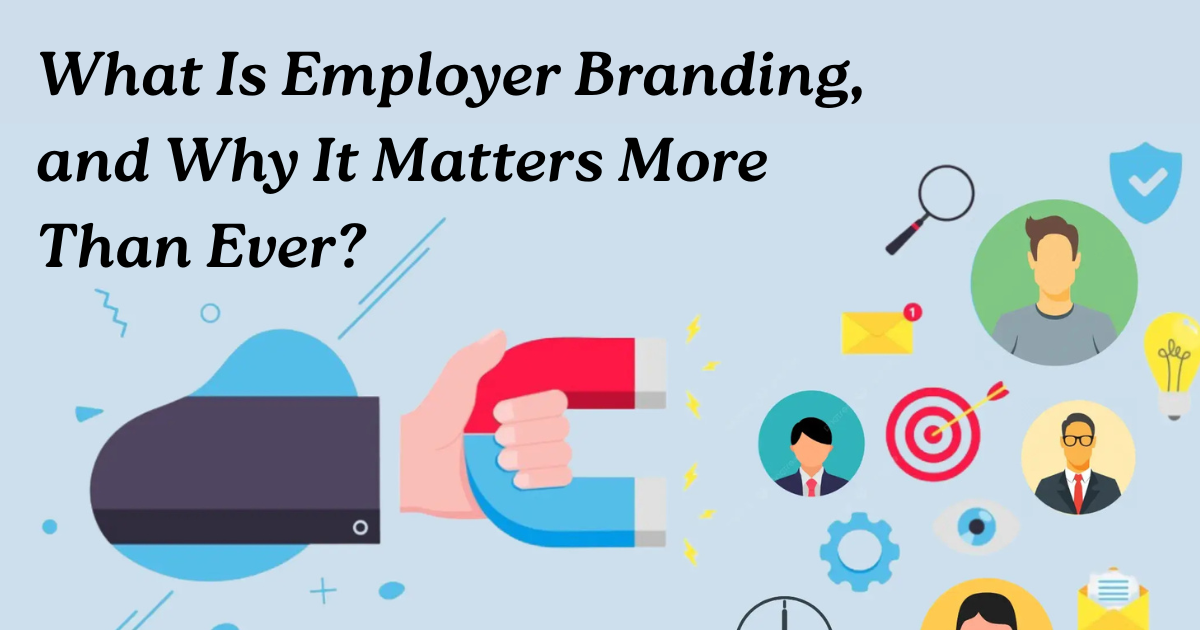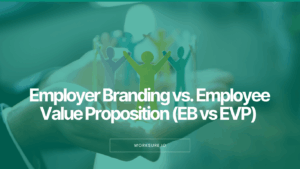What do top candidates think about a company before they ever speak to a recruiter?
It’s a question that’s often overlooked by hiring teams, yet it plays a critical role in whether the right candidates choose to engage with your brand at all. In many cases, it’s the very reason why high-caliber candidates decide not to apply.
The result? Missed opportunities, diluted talent pipelines, and rising recruitment costs.
In today’s transparent job market, your company’s reputation is shaped by what people see, hear, and share, often before you even interact with a potential hire. And once that perception is formed, it’s difficult to reverse.
That’s why a clear, consistent employer branding strategy is essential. In this blog, we’ll explore what employer branding is, why it’s important in modern recruitment, and how to create a brand that attracts, engages, and retains exceptional talent.
Table of Contents
What is Employer Branding?
Employer branding is the strategic process of shaping a company’s reputation as a desirable place to work, both for current employees and potential hires.
It reflects your company’s reputation in the job market, based on factors such as workplace culture, values, employee experience, hiring practices, and internal policies.
For example, Microsoft is consistently recognized as a top global employer. Why? Its brand highlights empathy, inclusive leadership, and a growth mindset. Candidates are drawn to Microsoft not only for innovation but also for a culture that supports learning and purposeful work.
This illustrates how a thoughtfully crafted employer branding strategy can shift perception, build loyalty, and help companies compete for talent on a global scale.
Key Elements of Employer Branding
To build a strong employer brand, focus on these core areas that shape how your company is perceived as a workplace:
1. Employee Value Proposition (EVP)
An EVP identifies the unique benefits and experiences employees can expect and aligns them with organizational values, culture, and career development.
The EVP is internal and defines your promise, while your employer brand is its external expression to attract and retain talent.
2. Company Culture
Culture is the lived experience of your workplace. It includes behaviors, leadership style, communication, and how people are treated daily.
A healthy, well-defined culture strengthens engagement, drives performance, and validates the promises made in your EVP.
3. Candidate Experience
Every step of the hiring process, from job discovery to onboarding, shapes how candidates perceive your organization.
A clear, respectful, and timely recruitment experience reflects professionalism and builds trust. On the other hand, poor communication or disorganized processes can damage your reputation and drive away top talent.
4. Internal Advocacy
Employees are the most credible brand ambassadors. Their experiences and stories carry more weight than corporate messaging.
Encouraging authentic employee advocacy through testimonials, referrals, or social sharing enhances your brand presence. Formalizing this through structured programs ensures alignment and consistency in what’s being shared.
5. Public Presence
An organization’s digital presence should consistently reflect its values, culture, and EVP. This includes the careers page, job postings, social media content, and employer review platforms.
Featuring real employee stories, success highlights, and behind-the-scenes culture content helps build a transparent and compelling employer image.

Why Does Employer Branding Matter?
According to a LinkedIn report, 75% of job seekers consider an employer’s brand before even applying, and 52% of candidates avoid companies with poor reputations even during unemployment.
The problem?
Many organizations still overlook employer branding as a strategic priority. While they invest heavily in customer marketing, they neglect the brand experience they offer employees. This disconnect results in weaker talent pipelines, higher turnover, and inflated recruitment costs.
Here are the key reasons why employer branding is important in recruitment:
1. Attracts Top Talent
A compelling employer brand attracts more qualified and motivated candidates, potentially leading to a higher-quality workforce. Strong employer brands can even attract passive candidates, those who are not actively searching for a job but might be interested in the right opportunity.
2. Increases Employee Engagement and Retention
“The single biggest thing you can do to attract talent is to build a great company culture.”
-Laszlo Bock—Former SVP of People Operations, Google
When employees feel aligned with your values and culture, they’re more likely to stay. A clear and consistent employer brand creates a positive and engaging work environment, leading to increased employee satisfaction and loyalty.
Google’s employer branding success was built on its focus on culture, values, and transparent hiring — the same pillars modern organizations should follow.
3. Reduces Recruitment Cost
When your brand attracts candidates organically, you spend less on recruitment marketing, job boards, and third-party agencies. In the long run, employer branding becomes a cost-efficient way to maintain a steady pipeline of qualified applicants.
A compelling employer brand can also shorten the hiring process by attracting a larger pool of qualified candidates.
“A strong employer brand can reduce cost per hire by up to 50% and lower employee turnover by 28%,” according to a LinkedIn report.
4. Strengthens Reputation and Trust
One bad candidate experience, one viral employee story, or one poor review can hurt your image. A solid employer brand protects you from that. It builds trust not only with candidates but also with customers, investors, and partners who value ethical and people-first companies.
How Do You Build a Strong Employer Brand?
To build a strong brand presence, follow these steps:
- Step 1: Understand What Makes Your Company Unique
- Step 2: Audit Your Current Employer Brand
- Step 3: Define Your EVP and Messaging
- Step 4: Share Your Brand Across the Right Channels
- Step 5: Monitor and Measure Employer Brand Impact
Below is the detailed overview of each of these steps.
Step 1: Understand What Makes Your Company Unique
Analyze the core attributes of your company before building an employer brand. This includes your mission, values, vision, culture, and business objectives. Defining these foundational elements allows you to shape a brand that accurately reflects who you are and the type of talent you aim to attract.
Step 2: Audit Your Current Employer Brand
Next, understand how your company is currently viewed both by candidates and your own employees. Use surveys, social media analysis, Glassdoor reviews, or even third-party reputation monitoring to gather insights.
Assess whether your actions align with your stated values. For instance:
- Are you communicating clearly during hiring?
- Do people experience what you say your company stands for?
- Would previous candidates reapply in the future?
- Would a former employee ever consider returning?
Identifying gaps between perception and reality is essential to refining your employer brand.
Step 3: Define Your EVP and Messaging
Your Employer Value Proposition (EVP) should align with your company’s identity and values while reflecting the real benefits and culture employees can expect.
Whether you do it in-house or bring in branding experts, ensure that your messaging feels genuine, consistent, and people-focused. The best employer brands mirror both the internal experience and the public promise.
Step 4: Share Your Brand Across the Right Channels
Once the EVP and core messaging are established, integrate them across all external and internal communication platforms.
Make sure your careers page, social profiles, and job descriptions all reflect your EVP. Highlight employee testimonials, share success stories, and use behind-the-scenes content to give people a real sense of what it’s like to be part of your team.
This is where your brand turns from words to real-world perception.
Step 5: Monitor and Measure Employer Brand Impact
Ongoing measurement is essential to determine the effectiveness of your employer branding strategy. Key performance indicators may include application rate, offer acceptance rate, cost per hire, quality of hire, retention rate, and source of hire.
These insights help you continually refine your approach and build a brand that not only attracts but also retains the right talent.
Concluding Thoughts
Employer branding plays an important role in how an organization is perceived by current and prospective employees. It influences who applies, who stays, and how people speak about the company.
By clearly defining what the organization offers, aligning internal practices with external messaging, and maintaining consistency, companies can build trust and attract the right talent both now and in the future.
Frequently Asked Questions (FAQs)
What is meant by employer branding?
Employer branding is the process of shaping how a company is perceived as a workplace. It includes the organization’s values, culture, employee experience, and reputation among current and prospective employees.
What is the primary purpose of employer branding?
The main purpose of employer branding is to attract, engage, and retain the right talent by shaping a consistent and credible image of the organization as an employer.
How to promote employer branding?
Employer branding can be promoted by:
- Sharing employee stories and testimonials.
- Maintaining an active and authentic presence on platforms like LinkedIn and Glassdoor.
- Ensuring job descriptions and career pages reflect the company’s culture and values.
- Encouraging internal advocacy and feedback from current employees.
Is employer branding part of HR?
Yes, employer branding is typically led by HR in collaboration with marketing and leadership. It is closely tied to recruitment, retention, and employee engagement strategies.





